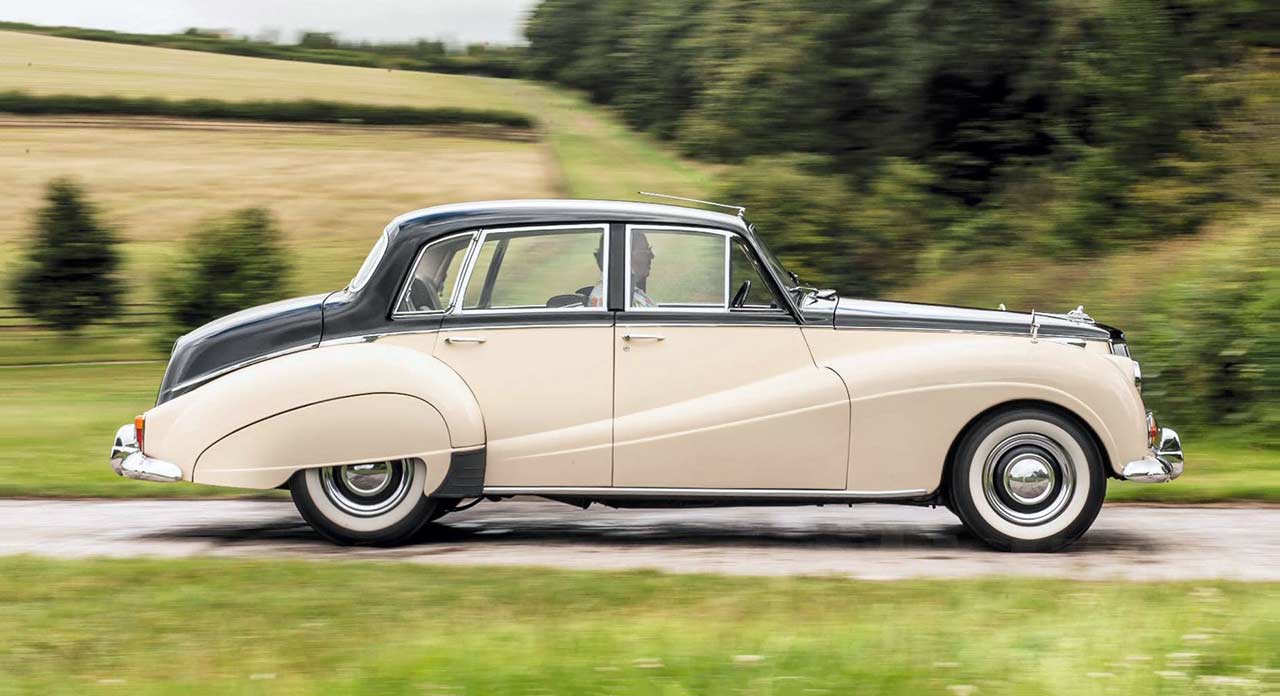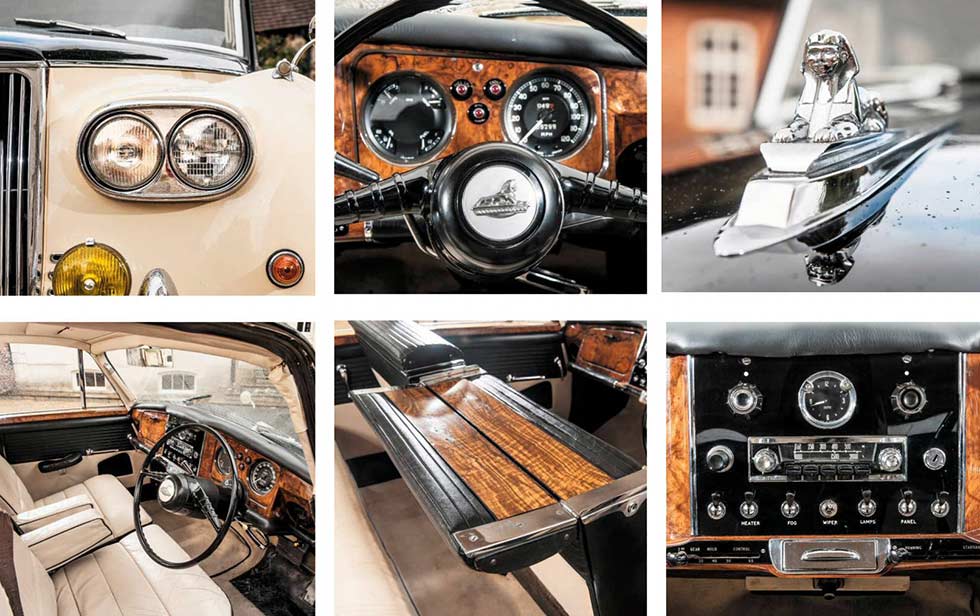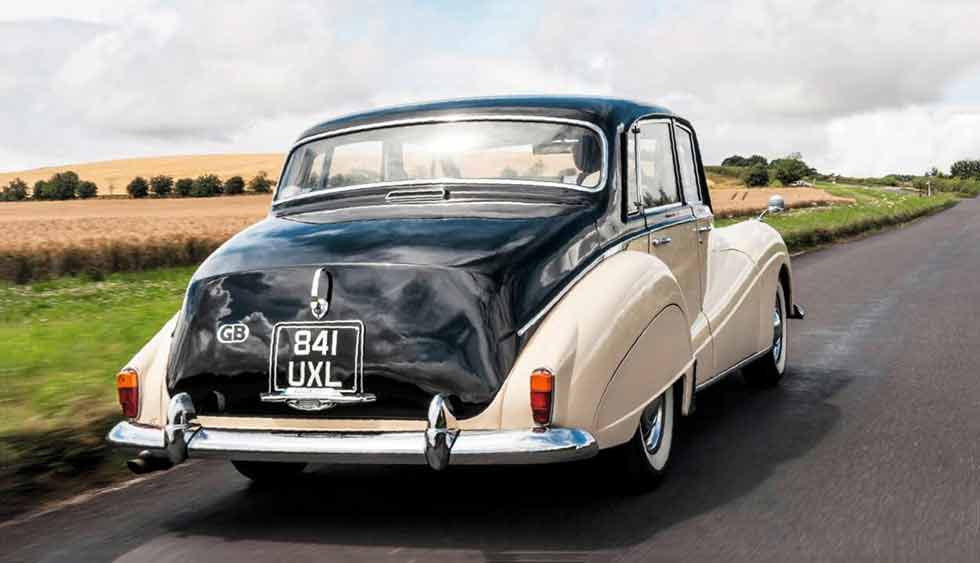
Only one Star Sapphire MkII was built before Armstrong Siddeley’s Bristol Aero merger brought car production to an end. Time to see what we lost out on… Words Andrew Roberts. Photography Laurens Parsons.
Rare Jewel We drive the Armstrong-Siddeley Star Sapphire MkII prototype that should have saved the marque – and find out why it didn’t succeed. Bentley? Daimler? No, it’s the Armstrong-Siddeley that might have been.
For me, as I suspect with many enthusiasts, there is always a fascination with those prototypes that promised so much for a car maker and yet never reached fruition for various technical, commercial or political reasons. The annals of the British motor industry are replete with the likes of the Humber Imperial V8, the Daimler V8-equipped Jaguar MkX and the four-wheel-drive ADO16-based Austin Ant, to name but three examples of Sixties models that might have been. The Armstrong Siddeley Star Sapphire MkII is another member of this group and while it’s interesting to read about such fine cars, it is infinitely more satisfying to encounter one in the metal.

Some cars proclaim their unique status with some exuberance – you could never mistake a 1968 Rover P9 for any other car, for example – but on meeting the Star Sapphire MkII I do an Ernie Wise-style double-take. According to its owner John Giacobbi, this is a common reaction at car shows when people first notice the four headlamps, then move to the rear to find a larger screen and a boot and wings reminiscent of the Sapphire Limousine.
As with all members of the Sapphire family, the MkII does not appear staid but its upright stance and slightly angular lines make it seem more formidable than the ostentatious Jaguar MkIX. The Armstrong is the sort of car that makes the novice driver mentally pull their socks up, but the multi-coloured leather upholstery gives the cabin a decidedly jolly touch.
Opening the driver’s door reveals a small step to assist my entrance and the fascia certainly doesn’t look as though it hails from 1960; I’m faced with a magnificent walnut-veneered panel variously studded with the controls for the fog lamps, petrol reserve and cigar lighter, with the choke controlled by an elaborate lever. After adjusting the steering wheel’s position and metaphorically straightening my tie I press the starter button, causing the Armstrong to not so much rumble as purr into life.
The origin of the MkII dates back to 1957 when Armstrong Siddeley was planning a major update of the Sapphire 346 that had been its staple automotive product since 1953. By the late Fifties, the market for British gentlemen’s conveyances had undergone a major change with the Jaguar MkVII range now typifying a changed era of ‘New Money’. In 1956 Armstrong had made a bold attempt at appealing to young up-and-coming architects or barristers with the compact 234/236 Sapphire, but despite their many strong points these were not a commercial success in comparison with the Rover P4 or the Jaguar 2.4 MkI.
When the Star Sapphire was introduced in 1958 it consolidated all that was good of its Sapphire 346 predecessors with many fine attributes of its own. The front doors were no longer hinged from the central pillar, the bonnet line was lower, the dashboard was modified and the engine was now a 4.0-litre unit with twin carburettors. As befitting a car of quality launched in the first year of the British motorway age, there was power-assisted steering and front disc brakes (a first for an Armstrong Siddeley) while the sole transmission choice was a Borg Warner DG ’box with an intermediate gear hold. The Star Sapphire was, and is, widely regarded as being as one of the finest of all Armstrong Siddeley motor cars but such quality inevitably required a large outlay.
Autocar thought that it was a car with ‘few equals even beyond its price range’ but at £2646 the Armstrong was nearly £500 more costly – and more than 10mph slower – than its MkIX rival from Browns Lane. The cars were expensive to make; there was actually no production line and the Sapphires were all hand-built.
By the standards of the very early Sixties the Burman power steering helps to make around 1500kg of motor car feel comparatively light when engaging in low-speed manoeuvring. Travelling at 40mph along the Wiltshire countryside in a unique Armstrong Siddeley can definitely be classed as one of my better experiences. The exterior may look sober but the Star Sapphire courteously urges you onwards. After a few miles, the MkII feels considerably smaller and lighter than its dimensions would suggest, with a beautifully flexible engine that is as suited to trundling at 30mph along a narrow rural lane as it is to A-road cruising at 70mph. Naturally, the occupants are well insulated from the noise of the engine and the steering has just the right balance of assistance while retaining a degree of feel. And then there’s the way it rides, with no ill-mannered wallowing or sudden pitching when travelling along poorly maintained highways.
Some large British cars of this era – I mention no names – lumber around corners in the style of an irate Robert Morley pursuing a teddy boy in a black-and-white comedy film, but the Armstrong driver need have few qualms about approaching narrow bends. The highly efficient brakes are another bonus, especially when driving in a part of the world where livestock might make a guest appearance on the road at any moment. Possibly my favourite aspect of the Star Sapphire is the quadrant control for the intermediate gear hold marked with numbers denoting 20, 30, 40, 50 and 65mph. It holds onto second gear until the Armstrong reaches the desired speed and in practice it is not just a precursor to a cruise control system but also tremendous fun to operate, giving novice Sapphire drivers such as myself the illusion of being in command of a steamship. To quote the late Brian Sewell, the Star Sapphire MkII achieves a ‘peculiarly English ideal of mechanical refinement and appeal as a sporting driver’s carriage’ and the experience of piloting at speed what appears to be a mobile gentleman’s study is one that I will always remember.
The Coventry firm produced only 980 Star Sapphires and in some respects it was a holding model intended to maintain the profile of the marque. It was also launched at almost the same time that Armstrong Siddeley Motors Ltd announced that it was to merge with Bristol Aero Engines to form Bristol Siddeley and before long, in Bale’s words, ‘The accountants became involved.’ At a time of major budgetary demands from the aviation side of the business the profit from the automotive division was deemed to be too low by the new management – the Star Sapphire was said to have made just £57 per car – and the MkII was devised to appeal to owners of the Bentley S-Type or the Alvis TD21 while Armstrong planned a new generation of models for the Sixties. ‘There are drawings of very stylish and tail-finned Armstrongs with no traces of the Sapphire’s lines,’ says Nick Bale of the Armstrong Siddeley Owners’ Club. Sadly, in July of 1960, shortly after this MkII was built, the company’s management decided to end production of the Star Sapphire and with it all cars bearing the sphinx logo. For the next six years the MkII served as the transport for the then-chairman of Bristol Siddeley Engines, amassing some 72,000 miles.
Apparently it also required five new automatic gearboxes during this time. With my own journey with it at an end, it’s time to take a few steps back to appreciate the MkII’s styling. Many of us can name examples of long-running models suffering from an ill-advised upgrade in desperate attempts to remain relevant – the Austin Allegro Equipe is just one case in point – but the Armstrong could never be accused of such solecisms. The paint scheme is contemporary without appearing at all uncouth, the quad-headlamp treatment is discreet and while opinions differ as to the aesthetic impact of the luggage compartment, it does not detract from the Armstrong’s sense of dignity. One challenge that the MkII did not overcome was the slightly awkward proportions of the cabin; the rear seat is quite cramped for such a sizeable car and I still treasure the Motor Sport road test that bemoaned the lack of space for top hats. However, this is a mere gripe because so many owners would have been delighted to give the chauffeur the month of.
One of the challenges for Armstrong Siddeley when developing the MkII was in making the Star Sapphire’s cabin even more luxurious. The MkI boasted a separate heater for the rear occupants and a demister for the rear screen while the front doors had lidded pockets and adjustable armrests – but the attention to detail in the MkII is little short of remarkable. The backrests of the front seats recline, the windows are controlled by quick-release levers – which must be used with discretion because the glass can shoot upwards with alarming speed – and there are seat belts both fore and aft, remarkable for a British car of the era. The front quarter-lights are sealed because the prototype is equipped with an air-conditioning system, allowing the driver to insulate his passengers from coffee bars, youths in winklepickers jiving to Apache by The Shadows, and all the other excesses and vulgarities of life in 1960.
Above all the Star Sapphire MkII has that sense of design integrity that is the hallmark of all great cars. With many of the classics I have previously encountered for the magazine there is often one aspect that exemplifies their quality and integrity of design, from the seating layout of the Renault 16TX and the suspension of the Citroën ID19 to the gear change of the two-stroke Saab 96. And the Armstrong Siddeley Star Sapphire MkII features integral head restraints that ingeniously double as picnic tables for the rear seat occupants. To some this may appear to be a minor aspect of the car but for me, it vividly illustrates the care and attention that Armstrong applied to the model that was intended to carry it forward into a new decade.
Having experienced the Star Sapphire MkII, I firstly desired to own it – a reasonably unlikely prospect it must be said – and secondly was struck by its almost paradoxical image. Looking at the Armstrong in repose, it’s nearly impossible to believe that it’s only eight years older than the first Jaguar XJ6 and predates the debut of the Rolls-Royce Silver Shadow by a mere five years. But when taking the wheel, it has the road manners of a much younger car and it’s intriguing to speculate on how successful it might have been had it entered small-scale production.
In the commercially vital US export market, the Star would probably have been limited to a distinct niche at a time when the affluent motorist expected the softly-sprung world of a top-of-the-range Cadillac, Lincoln or Imperial. A driver who was used to cosseting suspension, to regularly placing the Hydramatic gear selector in ‘Drive’, and revelling in V8 power might have been somewhat taken aback by the Armstrong, but a Don Draperstyle Madison Avenue denizen might have considered the Sapphire as an alternative to an imported Mercedes- Benz 300d Adenauer. As for the UK, the MkII would have been an almost exact contemporary of the Jaguar MkX but that was a different and less expensive form of a car, one more suited to the world of show-business and flamboyance. A far closer rival would have been the Daimler Majestic Major, another formal-looking hand-built vehicle whose Fifties-style coachwork belied its quite remarkable performance.
The advertisements for the original Star Sapphire claimed that it was a ‘Managing Director’s Car’ that was ‘tailor-made for the man at the top’ and ‘superb for the man who drives because he loves it, or because he must’. In my biased but genuine view, had the MkII version been given the green light it would have had equal appeal to the motorist who might otherwise have bought a Bentley S2. You can envisage a new Armstrong adapting with grace to a new London of tower blocks, or accelerating along the M1 past startled Mini Cooper drivers. True automotive class, as the Star Sapphire MkII so vividly demonstrates, is both indefinable and timeless.
Thanks to Rockley Manor (rockleymanor.com)
Tech and photos
TECHNICAL DATA FILE SPECIFICATIONS 1960 Armstrong Siddeley Star Sapphire MkII
Engine 3990cc inline-six ohv with twin Stromberg DIV 42 carburettors
Power and torque 145bhp @ 4250rpm, 230lb ft @ 2000rpm / DIN
Transmission Three-speed Borg Warner automatic, rear-wheel drive
Steering Recirculating ball with power assistance
Suspension Front: independent wishbones and coil springs. Rear: live axle with semi-elliptic springs
Brakes Discs front, drums rear, power assistance
Weight 1492kg (3290lb)
Performance Top speed: 100mph; 0-60mph: 15sec
Price new N/A, prototype
Classic Cars Price Guide £14,000-£48,500 (MkI)


‘You can envisage the Armstrong adapting with grace to a new London’
OWNING THE MKII
‘The essence of the design is from the post-war Festival-of-Britain epoch,’ says owner John Giacobbi.
‘When I’m out and about, people do recognise the car as an Armstrong Siddeley, and some ask if it’s a Sapphire or even a Star Sapphire. But classic enthusiasts always react in amazement when they see the headlamps.
‘You can see the care and attention that the factory put into the prototype. It’s a car of such carefully planned elegance in almost every detail. An obvious challenge of running the MkII is the uniqueness of some parts, but in terms of those it shares with its predecessor the Owners’ Club offers invaluable support and parts supply.’







